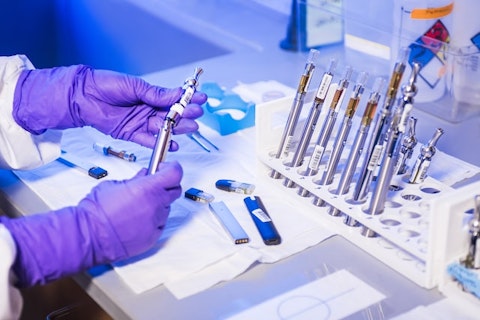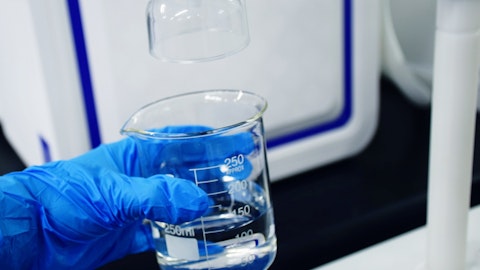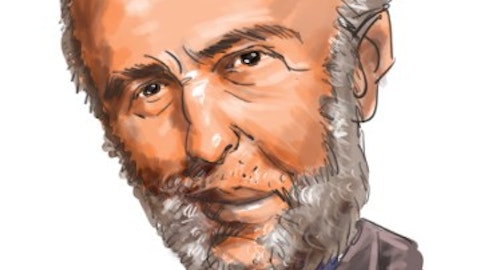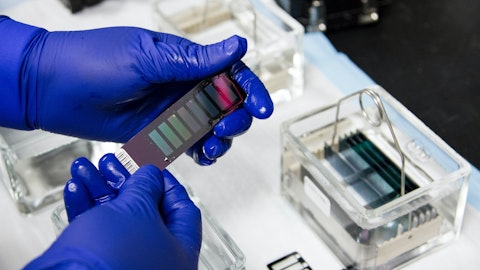Incyte Corporation (NASDAQ:INCY) Q4 2022 Earnings Call Transcript February 7, 2023
Operator: Hello, and welcome to the Incyte Fourth Quarter and Full Year Financial Results Conference Call and webcast. As a reminder, this conference is being recorded. It’s now my pleasure to turn the call over to Christine Chiou, Head of Investor Relations. Please go ahead, Christine.
Christine Chiou: Thank you, Kevin. Good morning, and welcome to Incyte’s Fourth Quarter and Full Year 2022 Earnings Conference Call and Webcast. The slides presented today are available for download on the Investors section of our website. Joining me on the call today are Hervé, Barry, Steven and Christiana, who will deliver our prepared remarks; and Dash, who will join us for the Q&A. Before we begin, I’d like to remind you that some of the statements made during the call today are forward-looking statements, and are subject to a number of risks and uncertainties that may cause our actual results to differ materially, including those described in our reports filed with the SEC. We will now begin the call with Hervé.
Hervé Hoppenot: Thank you, Christine, and good morning, everyone. 2022 was another successful year in which we delivered strong commercial performance and made significant advancements across all stages of our oncology and dermatology pipeline. Revenues from our current portfolio of commercialized products grew 18% year-over-year, both in the fourth quarter and for the full year to $764 million and $2.7 billion, respectively. Total revenues for the year, which include our royalty, grew 14% to $3.4 billion. As we look across our portfolio, the drivers of this double-digit growth are the continued commercial execution for Jakafi, net sales of which increased $275 million in the year to reach $2.4 billion and initial contributions from recently launched products and indications, including Minjuvi and Pemazyre in Europe and Japan and Opzelura in the U.S. I want to touch briefly on Opzelura, which we believe will be a significant growth driver for Incyte.
Opzelura was approved in September 2021 for atopic dermatitis. And this past July, we received approval and launched Opzelura in vitiligo as the first FDA-approved therapy for repigmentation. The approval was well received by dermatologists, patients and patient advocacy group and the launch has been very successful. Strong patient demand and increasing formulary access drove net sales of $61 million in the fourth quarter and $129 million for the full year. In 2023, we expect an approval for Opzelura in vitiligo in Europe, which adds another layer of growth for the franchise. Turning now to our regulatory and R&D achievements. Our clinical development pipeline is focused on three therapeutic areas: MPN GVHD, other hematology and oncology, and dermatology.
And we made significant progress across each of these three areas. In LIMBER, we presented new data from ongoing combination studies and disclosed an important new discovery asset targeting mutant CALR which has the potential to be a disease-modifying therapy for approximately 30% of patients in MF and ET. In other hematology and oncology, we presented updated data for our oral PD-L1 inhibitor 280, which shows promise both as a monotherapy and combination agent. We also progressed parsaclisib into Phase 3 for warm autoimmune hemolytic anemia, a disease in which there are no approved therapies. And in dermatology, we continue to expand our portfolio with Opzelura and povorcitinib, focusing in disease area where there is a significant unmet need.
Lastly, we had two important updates relating to patents. The first is that Incyte earned pediatric exclusivity, which entitled Incyte to six months of exclusivity added to our patents for Jakafi and Opzelura. This expands our ability to enforce our Jakafi patents through December 2028. This expansion further applied to our existing Opzelura patent. In addition, late last year, we obtained an issued patent and allowed claims for the treatment of atopic dermatitis and vitiligo, respectively. We are confident in the strength of these claims permitting us to protect Opzelura out to 2040 in the U.S. Before moving into the outlook for 2023, I wanted to take a moment to look back at the growth of our product revenues as shown on Slide 6. Over the past five years, approvals for new products and indications as well as strong commercial execution of our existing portfolio, has allowed us to grow our product revenues at a CAGR of 18%.
On Slide 7, looking at our historical operational performance. On the left is our revenues versus our total R&D and SG&A spend. We have delivered strong operational performance over the past five years with total revenue growing at a 17% CAGR and our operating expenses growing at a 13% CAGR. On the right, we are showing our operating leverage, excluding the impact of dermatology on revenues, and sales and marketing expenses. Here, you can see our operating performance is even more pronounced. We can expect to drive further operating leverage over time with our high-growth dermatology franchise, which is in early stages of launch and where we could see two additional approvals in the near term. Turning to Slide 8. As we look ahead for Incyte, there are four main drivers of sustainable growth, and we are already making significant progress in each of these areas and expect to continue to strong momentum throughout — to continue the strong momentum throughout 2023.
The first driver is our Jakafi franchise and LIMBER program, where we aim to expand our leadership in MPN and GVHD. In 2023, beyond the approval of ruxolitinib XR, we expect important data, including pivotal results for our parsaclisib combination in suboptimal responders to Jakafi in MF. Next is Opzelura where we are launching in AD and vitiligo and where in 2023, we will be launching in Europe. In other areas of clinical development, we expect new data from our oral PD-L1 program and povorcitinib in prurigo nodularis and vitiligo. Lastly, we will be monitoring early data from our CDK2 and mutant CALR program. With that, I would like to pass the call to Barry.
Barry Flannelly: Thank you, Hervé, and good morning, everyone. In the fourth quarter, Jakafi net sales grew 9% year-over-year to $647 million and grew 13% for the full year to $2.4 billion. Total patient demand rose 7% in 2022, driven by an increase in new patients across all indications. The launch of Jakafi in chronic GVHD continues to be strong with the total number of patients in Q4 growing 11% versus prior year quarter. A key driver of growth in GVHD is the duration of therapy; and based on recent data, the average duration, which includes both acute and chronic, is approximately 15 months. On Slide 11, as you can see on the left, Jakafi has grown consistently year-over-year ranging from $200 million to $250 million each year.
We expect to continue strong growth in 2023 with full year net product revenues to be between $2.53 billion to $2.63 billion. Turning to Opzelura on Slide 12. We had a strong quarter for Opzelura with continued double-digit sequential growth in patient demand in atopic dermatitis and a very successful launch in vitiligo. As you can see on the chart on the right, total demand, which includes both free and paid drug, grew 34% in Q4 versus prior quarter to reach 84,700 units, driven by both new patient growth and an increasing number of refills. Paid demand, as shown by the light blue bars, grew 52% in Q4, driven by continued improvements in formulary access. As a result, net sales grew 61% versus prior quarter to $61 million. Total full year net sales for Opzelura were $129 million.
Looking ahead, we expect both AD and vitiligo to be significant growth drivers for Opzelura. In AD, Opzelura is the #1 prescribed branded agent for new AD patients and its impact on itch, which remains unmatched by any other topical therapy continues to be the primary driver of prescribing. We expect the efficacy profile of Opzelura to continue to drive uptake in AD. In terms of additional near-term growth opportunities, pending the results from the Phase 3 trial, we could see an approval in pediatric AD next year for two to 11-year olds. In vitiligo, the size of the market and the potential opportunity is substantial. There are an estimated 1.5 million patients diagnosed with vitiligo in the U.S. And prior to Opzelura’s approval, an estimated 150,000 to 200,000 patients were motivated to seek treatment.

Photo by CDC on Unsplash
As you know, Opzelura is the first and only product to be approved to help patients repigment their skin and this provides us with an opportunity to activate many of the 1.3 million patients that are naive to treatment or who have stopped seeking treatment altogether. And in the next few months, we expect the approval of Opzelura in vitiligo in Europe, where there are an estimated 1.5 million diagnosed patients living with the disease. Slide 14 shows a few examples of patient advocacy and consumer activity within the vitiligo community. We are already seeing high awareness and excitement for Opzelura from patients, and we will continue to build on that momentum throughout the year, including the commencement of TV direct-to-consumer this quarter.
And lastly, on Monjuvi, Minjuvi and Pemazyre. Monjuvi sales in Q4 were $24 million, up 13% year-over-year, and revenues were $89 million for the year. The launch of Minjuvi is ongoing in four markets, and we continue to gain reimbursement in other European countries. Net sales for the full year were $20 million, which includes a negative $2 million of foreign exchange impact. Pemazyre grew to $83 million in net sales in 2022 with $20 million coming from outside the U.S.; again, negatively impacted by foreign exchange by $3 million. In the U.S. Pemazyre continues to grow in total patients on therapy and is established as the standard of care for patients living with cholangiocarcinoma with FGFR2 alterations. With that, I’ll turn the call over to Steven.
Steven Stein: Thank you, Barry, and good morning, everyone. We made significant progress across our clinical development portfolio in 2022. We had multiple clinical and regulatory achievements throughout the year and I would like to use the next few slides to highlight a few of the key programs. Starting with our LIMBER program on Slide 18. Key data were presented at the 2022 American Society of Hematology Annual Meeting where we had 57 abstracts accepted for presentations. Highlighting two of those presentations, starting on the left, we presented initial results of the Phase 1/2 study evaluating our ALK2 inhibitor zilurgisertib in monotherapy and in combination with ruxolitinib, which demonstrated improvement in anemia and hemoglobin responses in patients with myelofibrosis.
Additionally, we disclosed our discovery of 989, a novel anti-mutant calreticulin monoclonal antibody, which has been shown to selectively inhibit the proliferation and differentiation of cells harboring mutant CALR, while not affecting wild type or normal healthy cells. On the right is a list of key updates across LIMBER that are expected this calendar year. Starting with ruxolitinib XR, we have a PDUFA date of March 23 this year, and the expected approval is an important step towards fixed-dose combinations with parsaclisib, zilurgisertib and our BET inhibitor. In terms of data, we expect pivotal Phase 3 data of ruxolitinib plus parsaclisib in suboptimal responders as well as more mature data sets of ruxolitinib with ALK2 and BET in the second half of this year.
Depending on what we see with our ALK2 and BET combinations, we could potentially see the start of pivotal trials with one or both of these compounds. Early in the pipeline is our anti-mutant CALR monoclonal antibody, which will enter the clinic this year. With regards to graft versus host disease, we are expecting pivotal data midyear from AGAVE-201, a study evaluating axatilimab in third-line chronic graft versus host disease. Moving to the rest of our hematology and oncology portfolio. Key data for the small molecule oral PD-L1 program were presented at the Society of Immunotherapy of Cancer Annual Meeting. Both 280 and 318 demonstrated clinical activity with tumor shrinkage and were generally well tolerated and we expect to share more mature data set in the second half of this year.
In addition, we plan to initiate combination trials of 280 with adagrasib, CTLA-4 and an oral VEGF inhibitor in the first half of this year. INCB123667, our novel potent and selective oral small molecule inhibitor of CDK2 entered Phase 1 clinical development. Yes, we could see utility in cyclin E amplified or overexpressing cancers as well as in cancers that are resistant to CDK4/6 inhibitors. Now looking at our dermatology franchise on Slide 20. In July of last year, Opzelura gained its second indication in vitiligo. This was a huge achievement for the vitiligo community and people living with the disease. As we continue to maximize the potential with ruxolitinib cream, we initiated multiple Phase 2 studies in different conditions, including lichen planus, lichen sclerosis and hidradenitis suppurativa.
In each of these diseases, there are no topical or oral therapies approved. We have many important milestones in dermatology upcoming in 2023, ruxolitinib cream, the CHMP opinion in vitiligo is currently on track for the first quarter of this year, while data from the Phase 3 vitiligo maintenance and withdrawal study and the Phase 3 pediatric AD study will be available in the first and second half, respectively. Turning to povorcitinib. We expect Phase 2 data in both vitiligo and prurigo nodularis later this year. And additionally, I want to highlight that later this week at the European Hidradenitis Suppurativa Foundation we have an oral presentation of the updated 52-week data from our Phase 2 study in HS, which should provide some additional insights into the durability of response with this agent.
And lastly, auremolimab our newly acquired IL-15 receptor beta monoclonal antibody is expected to enter the clinic for vitiligo. As you can see on Slide 21, we’re looking forward to another busy year with multiple regulatory and clinical updates. With that, I would like to turn the call over to Christiana for the financial update.
Christiana Stamoulis: Thank you, Steven, and good morning, everyone. Our fourth quarter results reflect continued strong revenue growth with total product revenues of $764 million, representing an increase of 18% over the fourth quarter of 2021. Total product revenues are comprised of $647 million for Jakafi, $55 million for other hematology/oncology products and $61 million for Opzelura. Net product revenue growth was primarily driven by increases in Jakafi and Opzelura net revenues. Other hematology/oncology net revenues, which include revenues from Iclusig, Pemazyre and Minjuvi were impacted by unfavorable changes in FX rates. On a constant currency basis, other hematology/oncology net product revenues grew by 23% over the prior year period.
Total royalty revenues for the quarter were $132 million and are comprised of royalties from Novartis of $91 million for Jakavi and $4 million for Tabrecta and royalties from Lilly of $36 million for Olumiant. Jakavi and Olumiant royalties for the quarter were negatively impacted by FX headwinds, while Olumiant royalties were also impacted by a decrease in net product sales of Olumiant for use as a treatment for COVID-19. Excluding the impact of COVID-19 related sales and currency fluctuation, Olumiant royalties increased 23% compared to the prior year period. For the full year 2022, total net product revenues were $2.7 billion and total revenues were $3.4 billion, representing 18% and 14% year-over-year increase, respectively. Moving to Slide 25.
Opzelura net product revenues for the quarter were $61 million, driven by robust demand and broadening payer access. As payers continue to add Opzelura to formularies and the share of covered claims increase, we continue to see improvement in the gross to net discount rate. The gross to net discount rate decreased from an average of 71% in the third quarter of 2022 to an average of 57% in the fourth quarter of this year, and we exited 2022 at a gross to net discount rate of 50%. While we will continue to work on reducing patient co-pay and in turn, improving gross to net, an average gross to net of 50% is a good working assumption for 2023 with a gross net discount in the first quarter of the year expected to be higher than subsequent quarters as plans reset patient deductibles at the beginning of the year.
I would also like to take the opportunity to update you on the Opzelura prescriptions data provided by IQVIA. As you see on Slide 26, in Q4, we saw the gap between the actual number of total prescriptions and the number of prescriptions reported by IQVIA, narrowing. While the IQVIA data continues to overstate demand, this overstatement has been reduced to a level of 5% to 10%, which is within expectations for a newly launched product. In addition, it is important to note that IQVIA data reflects total demand, which includes both paid prescriptions and free drug. Going forward, free drug is expected to represent around 20% of total demand. When looking at IQVIA data, one would need to adjust for this overstatement as well as for free drug in order to get a better sense of paid demand.
Moving on to Slide 27 and our operating expenses on a GAAP basis. Ongoing R&D expenses were $431 million for the fourth quarter and $1.5 billion for the full year 2022. Total R&D expenses, which include the upfront consideration of $70 million for our acquisition of Villaris were $501 million for the fourth quarter. For the full year 2022, total R&D expenses, which in addition to the Villaris upfront payment also include $56 million in other milestone payment, were $1.6 billion representing a 9% year-over-year increase. The increase was primarily due to the progression of our pipeline and was partially offset by lower upfront and milestone expenses in 2022. Total SG&A expenses were $273 million for the fourth quarter and $1 billion for the full year 2022.
The year-over-year increase was driven by investments related to the new dermatology commercial organization in the U.S. and the related activities to support the launch of Opzelura in atopic dermatitis and vitiligo. Moving on to 2023. I will now discuss the key components of our guidance on a GAAP basis. For Jakafi, we expect net product revenues to be in the range of $2.53 billion to $2.63 billion, which at the midpoint represents an increase of approximately $170 million over 2022, driven by continued growth across all indications. We expect our gross to net adjustments for 2023 to be approximately 23%, reflecting expected continued growth in 340B volumes. As a reminder, the gross to net adjustment in the first quarter of the year is always higher relative to other quarter and previous quarter and subsequent quarters due to our share of the donut hole for Medicare participation.
For other hematology/oncology products, which include Pemazyre in the U.S., EU and Japan, and Iclusig and Minjuvi in Europe, we are expecting total net product revenues to be in the range of $215 million to $225 million. Turning to operating expenses on a GAAP basis, we expect COGS in a range of 7% to 8% of net product revenues, which is in line with 2022. R&D expenses are expected to be in the range of $1.61 billion to $1.65 billion, representing 3% year-over-year growth at the midpoint. SG&A expenses are expected to be in the range of $1.05 billion to $1.15 billion, primarily reflecting continued investment in Opzelura and the full year impact of the investment in the vitiligo indication. Operator, that concludes our prepared remarks. Please give your instructions and open the call for Q&A.
See also 25 Most Famous Companies in the World and 10 Best January Dividend Stocks To Buy.
Q&A Session
Follow Incyte Corp (NASDAQ:INCY)
Follow Incyte Corp (NASDAQ:INCY)
Operator: Our first question today is coming from Salveen Richter from Goldman Sachs.
Salveen Richter : Congratulations on the quarter. Two questions for me. One is, I recognize you do not provide Opzelura guidance for this year. But can you provide any details on duration of treatment or number of tubes per year in average for an AD patient and how it might play out in vitiligo. And are there any inventory dynamics to highlight here? The second question is on the BET and ALK2 inhibitor combinations. Can you speak to your confidence in these programs? Now given the early data, do you think that represented proof of concept? And what do you want to see on the forward to move into later-stage studies?
Barry Flannelly : Sure. Salveen, I’ll answer the first part of the question — or the first question and get it to Steven afterwards. So just in terms of duration of therapy for Opzelura in vitiligo, it’s obviously very early in the launch. So as far as continued duration of therapy, you know what, the study had continued through 52 weeks and beyond. And the tubes per year, we’ve said before that the average tubes per year, we think will be about 10 for vitiligo patients. In terms of inventory at the end of the year, it’s actually very low. The inventory was more like two to three weeks, just standard inventory that we would have on hand. Steven?
Steven Stein : Thanks, Salveen. I’ll just separate out both programs. So I’ll start with the ALK2 program. We are very excited at the end of the year to receive towards the end of the year the update in terms of ALK2 showing increases in hemoglobin. Prior to that, we had seen proof of mechanism in terms of hepcidin decreases, but we hadn’t seen hemoglobin move. And then both in the monotherapy escalation and in combination with RUX, we saw a few patients with quite substantial hemoglobin increases, which gave us a lot more confidence in that program going forward. For this year, in the beginning of the year, we’ll continue to dose escalate. We still had relatively low doses, particularly in combination with RUX to get towards a maximum effect.
We don’t expect to see much in terms of tolerability, in terms of negative side effects at all. The populations that would be in scope for pivotal studies to begin with, the obvious one would be anemic patients with transfusion dependence to convert them to independents, but then standard anemic patients with anemia from the underlying MF and then potentially all comers. And the reason is the dual effect, so both to treat the underlying anemia from myelofibrosis itself and then to ameliorate or even reverse the ruxolitinib-induced anemia, which will allow you to maintain RUX dose intensity. And we know when we do that, that we increase the efficacy of ruxolitinib. So we’re extremely encouraged by what we’ve seen with ALK2. We’ll continue to dose escalate and then we’ll make pivotal decisions on what population or populations to go after with their program towards the end of this year.




